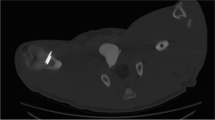Abstract
Purpose
The purpose of this study was to evaluate the different temperature levels whilst drilling cemented and cementless hip prostheses implanted in bovine femora, and to evaluate the insulating function of the cement layer.
Methods
Standard hip prostheses were implanted in bovine donor diaphyses, with or without a cement layer. Drilling was then performed using high-performance-cutting drills with a reinforced core, a drilling diameter of 5.5 mm and cooling channels through the tip of the drill for constantly applied internal cooling solution. An open type cooling model was used in this setup. Temperature was continuously measured by seven thermocouples placed around the borehole. Thermographic scans were also performed during drilling.
Results
At the cemented implant surface, the temperature never surpassed 24.7 °C when constantly applied internal cooling was used. Without the insulating cement layer (i.e. during drilling of the cementless bone–prosthesis construct), the temperature increased to 47 °C.
Conclusion
Constantly applied internal cooling can avoid structural bone and soft tissue damage during drilling procedures. With a cement layer, the temperatures only increased to non-damaging levels. The results could be useful in the treatment of periprosthetic fractures with intraprosthetic implant fixation.





Similar content being viewed by others
References
Rayan F, Haddad F (2010) Periprosthetic femoral fractures in total hip arthroplasty—a review. Hip Int 20(4):418–426
Lever JP, Zdero R, Nousiainen MT, Waddell JP, Schemitsch EH (2010) The biomechanical analysis of three plating fixation systems for periprosthetic femoral fracture near the tip of a total hip arthroplasty. J Orthop Surg Res 5:45. doi:10.1186/1749-799X-5-45
Muller M, Kaab M, Tohtz S, Haas NP, Perka C (2009) Periprosthetic femoral fractures: outcome after treatment with LISS internal fixation or stem replacement in 36 patients. Acta Orthop Belg 75(6):776–783
Tarnowski JR, Holck K (2008) Osteosynthesis of a periprosthetic fracture of the proximal femur with the distal femur LISS system. Acta Orthop Belg 74(1):125–127
Brand S, Klotz J, Hassel T, Petri M, Haasper C, Bach FW, Krettek C, Goesling T (2012) Intraprosthetic fixation techniques in the treatment of periprosthetic fractures—a biomechanical study. World J Orthop 3(10):162–166. doi:10.5312/wjo.v3.i10.162
Brand S, Klotz J, Petri M, Ettinger M, Hassel T, Krettek C, Goesling T, Bach FW (2013) Temperature control with internally applied cooling in solid material drilling: an experimental, biomechanical study. Int Orthop. Mar 20 [Epub ahead of print]. doi:10.1007/s00264-013-1850-4
Augustin G, Davila S, Udiljak T, Vedrina DS, Bagatin D (2009) Determination of spatial distribution of increase in bone temperature during drilling by infrared thermography: preliminary report. Arch Orthop Trauma Surg 129(5):703–709. doi:10.1007/s00402-008-0630-x
Augustin G, Davila S, Mihoci K, Udiljak T, Vedrina DS, Antabak A (2008) Thermal osteonecrosis and bone drilling parameters revisited. Arch Orthop Trauma Surg 128(1):71–77. doi:10.1007/s00402-007-0427-3
Augustin G, Davila S, Udilljak T, Staroveski T, Brezak D, Babic S (2012) Temperature changes during cortical bone drilling with a newly designed step drill and an internally cooled drill. Int Orthop 36(7):1449–1456. doi:10.1007/s00264-012-1491-z
Lundskog J (1972) Heat and bone tissue. An experimental investigation of the thermal properties of bone and threshold levels for thermal injury. Scand J Plast Reconstr Surg 9:1–80
Bertollo N, Milne HR, Ellis LP, Stephens PC, Gillies RM, Walsh WR (2010) A comparison of the thermal properties of 2- and 3-fluted drills and the effects on bone cell viability and screw pull-out strength in an ovine model. Clin Biomech (Bristol, Avon) 25(6):613–617. doi:10.1016/j.clinbiomech.2010.02.007
Rafel SS (1962) Temperature changes during high-speed drilling on bone. J Oral Surg Anesth Hosp Dent Serv 20:475–477
Wiggins KL, Malkin S (1976) Drilling of bone. J Biomech 9(9):553–559
Fuchsberger A (1987) Effect of temperature on compact bone in saw cutting in relation to the conditions of use. Zentralbl Chir 112(12):793–804
Matthews LS, Hirsch C (1972) Temperatures measured in human cortical bone when drilling. J Bone Joint Surg Am 54(2):297–308
Abouzgia MB, James DF (1995) Measurements of shaft speed while drilling through bone. J Oral Maxillofac Surg 53(11):1308–1315, discussion 1315–1306
Abouzgia MB, Symington JM (1996) Effect of drill speed on bone temperature. Int J Oral Maxillofac Surg 25(5):394–399
Reingewirtz Y, Szmukler-Moncler S, Senger B (1997) Influence of different parameters on bone heating and drilling time in implantology. Clin Oral Implants Res 8(3):189–197
Lavini FM, Brivio LR, Leso P (1994) Biomechanical factors in designing screws for the Orthofix system. Clin Orthop Relat Res 308:63–67
Statement
All authors have participated in the research presented. The article has not been submitted elsewhere. An IRB Approval is not necessary with this study design.
Conflicts of interest and source of funding
For all authors none declared.
Author information
Authors and Affiliations
Corresponding author
Rights and permissions
About this article
Cite this article
Brand, S., Klotz, J., Hassel, T. et al. Different thermal conductivity in drilling of cemented compared with cementless hip prostheses in the treatment of periprosthetic fractures of the proximal femur—an experimental biomechanical analysis. International Orthopaedics (SICOT) 37, 1885–1889 (2013). https://doi.org/10.1007/s00264-013-1964-8
Received:
Accepted:
Published:
Issue Date:
DOI: https://doi.org/10.1007/s00264-013-1964-8




